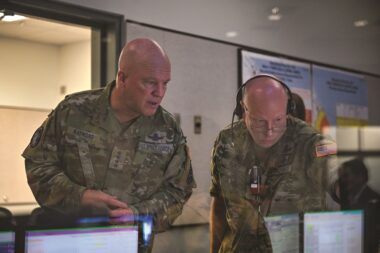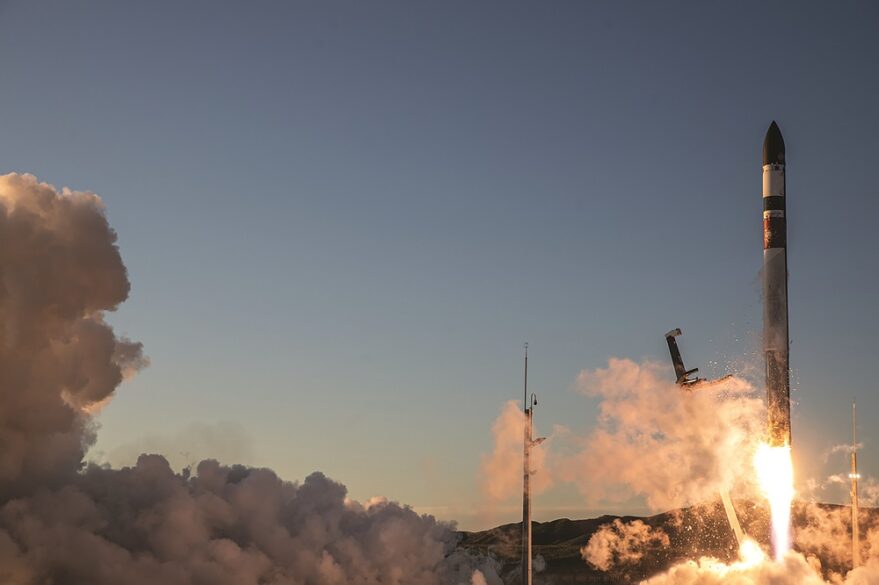
Launch on demand: If satellites are shot down, will Space Force be ready to restock? (Image Credit: Space News)

A small satellite mission the U.S. Space Force plans to launch in 2023 will test the ability of the commercial space industry to deploy a payload on an extraordinarily compressed timeline.
A contract for the mission, code-named Victus Nox, was awarded Sept. 30 to launch services provider Firefly Aerospace and satellite manufacturer Millennium Space. Once the Space Force decides when the mission must launch, it will give Millennium a few months to produce the spacecraft and Firefly will only get 24 hours’ notice to get ready for liftoff.
The point of Victus Nox — Latin for ‘conquer the night’ — is to demonstrate fast turnaround launch operations, known as tactically responsive space, and to help planners figure out the front-end processes leading up to the launch. This capability, strategists warn, will be needed during an armed conflict to augment constellations or replace satellites that adversaries would damage or blow up.
“We need to be able to get to the point where we can go launch a rocket, a mission in 24 hours and get that data flowing,” Brig. Gen. Stephen Purdy, the Space Force’s program executive officer for assured access to space, said Sept. 20 at the Air & Space Forces Association annual conference.
A 24-hour call-up is “almost unobtainium right now,” he said. “But we need to get to that point.”
The idea of responsive space launch has been talked about for years but is now gaining attention due to congressional and industry advocacy, as well as world events that have shown the strategic value of satellites, making them more attractive targets.
Congress has criticized the Pentagon for not moving more quickly in this area and, over the past two years, inserted $65 million into the defense budget for tactically responsive spaceflight demonstrations. For 2023, the House Armed Services Committee and the Senate Appropriations defense subcommittee are proposing $100 million, although the final amount has yet to be negotiated.
“As vividly demonstrated by Russia’s 2021 destructive anti-satellite test, threats to our critical national security space assets continue to increase, both from adversary on-orbit and terrestrial counter-space capabilities and from space debris,” a bipartisan group of 25 lawmakers wrote in a letter sent in January to appropriators.
Meanwhile, the United States is “not currently positioned with an operational capability to rapidly replace assets in orbit that are degraded, disabled, or destroyed or to rapidly launch satellites for urgent new missions,” the letter said.
Small-satellite launch companies like Virgin Orbit and Rocket Lab have lobbied for this funding, arguing that the Defense Department should create a program of record with long-term budgets for tactically responsive launch. The letter to appropriators said, “robust investment in tactically responsive small launch in 2022 will help accelerate this emerging industry’s efforts to lower launch costs.”
Amid congressional pressure to accelerate responsive launch demonstrations, the Space Force, in June 2021, conducted the Tactically Responsive Launch-2 (TacRL-2) mission on a Northrop Grumman air-launched Pegasus XL rocket from Vandenberg Space Force Base, California.
Northrop Grumman was given 21 days’ notice to get ready to launch a small surveillance satellite to low Earth orbit.
The Space Force has since renamed the program Tactically Responsive Space, so Victus Nox will be TacRS-3. The name change emphasizes that launch is just one piece of what it takes to accelerate space missions.
IT’S MORE THAN JUST LAUNCH
Gen. John “Jay” Raymond, chief of space operations of the U.S. Space Force, has been a long-time proponent of using commercial systems to speed up the military’s much slower development cycles.
In an interview with SpaceNews, Raymond noted that responsive space is far from a new concept, but it is now more achievable because of the technology and business practices introduced by the commercial industry.

In 2005 when Raymond was a strategist at the Defense Department’s Office of Force Transformation, he co-authored a paper with the office director, Adm. Arthur Cebrowski, titled “Operationally Responsive Space: A New Defense Business Model.”
The paper said DoD should have the ability “to reconstitute larger space capabilities if adversaries succeed in finally developing capabilities to negate them.”
Raymond said that paper was ahead of its time because the technology was not available to do responsive space missions. “Now, if we do this right, it will allow us to capitalize more on commercial capabilities.”
Even to this day, national security space launch is a process that begins years in advance and relies on expensive, fixed infrastructure, he noted. There are now more flexible launch options like airplanes that deploy small rockets and small vertical launch vehicles that can operate from multiple locations.
But what still has to be worked out is the “end to end” process for responsive space, Raymond said. No matter how quickly rockets can get to the pad, it doesn’t matter if the satellites are not ready, and there are regulatory requirements that have to be coordinated.
The next major step for responsive space is to “develop the operational concept for how you replenish these constellations and how you might use responsive capabilities,” said Raymond.
Also needed is a clearly articulated requirement that has to be approved by the Pentagon in order to get funded, he said. “We’ve got to figure out the operational concepts and then have the requirements as we continue to experiment.”
A requirement is being drafted by U.S. Space Command, the organization responsible for determining a response plan if satellites come under attack. Raymond said demonstrations like TacRS-3 would help the command understand the art of the possible. There will likely be more demo flights, “but I want to progress from just doing experiments to no-kidding, real capability.”
Raymond’s successor as chief of space operations, Lt. Gen. B. Chance Saltzman, said he intends to continue to support tactically responsive launch efforts.
“If confirmed, the most critical issue I would address is expanding the scope of tactically responsive space to ensure we generate complete operational capabilities,” he said in written testimony submitted to the Senate Armed Services Committee for his Sept. 13 confirmation hearing.
“We must have end-to-end capabilities that include launch vehicles, satellites, ground systems and operational concepts,” he said. “And most importantly, the specific requirements of the combatant commanders, that enable a tangible response to potential adversary destabilizing actions in space.”
TABLETOP EXERCISE AT CAPE CANAVERAL
The Space Systems Command in September held a three-day tabletop exercise at Cape Canaveral Space Force Station, Florida, to examine the processes and the bureaucratic ins and outs of launching payloads on short notice.
Col. James Horne, Space Systems Command’s deputy director of operations, said the lessons from this exercise would help plan the TacRS-3 mission and inform future budgets.
A takeaway from the tabletop exercise, said Horne, is the need to involve all stakeholders, including the Space Force, U.S. Space Command, the Federal Aviation Administration, the Federal Communications Commission, and other agencies that have regulatory responsibilities.
“We looked at how we would execute a responsive launch, all the way from receiving orders from the combat commanders to delivering usable data to the warfighter with boots on the ground,” said Capt. Benjamin Vowell, chief of wargames and exercises at Space Systems Command.
“We learned that there are organizational things that we need to work through,” said Vowell. “This exercise was a way for us to pull the various threads and understand how we can enable responsive space.”
A central question, for example, is what it will take to integrate a satellite on the rocket so the launch provider can meet the 24-hour call-up. Processes like frequency allocation and approval and notifications to ships and aircraft would have to be dramatically accelerated.
The infrastructure needed to conduct rapid launches is another major issue, said Master Sergeant Travis Ferguson, launch operations manager at Space Systems Command.
“Our first option may be to just turn to a commercial contract and buy a capability depending on what mission area you’re talking about,” he said. “Or we could turn to an ally and ask them if we can use their assets.”
Lt. Gen. Michael Guetlein, head of Space Systems Command, said the demonstration in 2023 will give decision makers a better grasp of “where tactically responsive space can fill a wartime or crisis requirement.”
Back in 2018, similar questions were raised by the Defense Advanced Research Projects Agency when it announced a Launch Challenge prize competition.
DARPA offered $10 million to any space company that could launch a payload to low Earth orbit with just a few days to prepare and do it again a couple weeks later. The effort was unsuccessful and ended when Astra, the lone challenge participant, scrubbed its launch in Kodiak, Alaska, less than a minute before liftoff.
Chris Bassler, a senior fellow at the Center for Strategic and Budgetary Assessments, said DARPA’s launch challenge shined a spotlight on responsive space but didn’t drive any policy or funding decisions at DoD.
The proliferation of anti-satellite weapons means it’s just a matter of time before the United States faces a real-world situation when it will need to restock, Bassler said.
DoD and the Space Force have stood by over the past couple of years while Congress has kept adding money to the program, Bassler said. The Space Force’s explanation that it doesn’t have specific requirements for rapid-response launch, he said, is a weak excuse.
“They do have a requirement to provide space capability even if attacked or degraded, so it’s implicit that they need replenishment options, and that is something that should be funded,” he added.
Investments in spaceports and agreements to launch from foreign countries would be needed in order to move away from DoD’s dependence on East and West Coast ranges, he said. The Space Force also needs to start working with multiple launch providers to try out different concepts and should accelerate the use of in-orbit servicing so satellites can be repaired.
The responsive space demonstration missions are a step in the right direction, Bassler said. However, things are still “moving very slowly considering the threat pace that keeps being talked about, China clearly being the most concerning.”
DOD IS AN ESSENTIAL CUSTOMER FOR SMALLSAT LAUNCHERS
A military program focused on launching payloads in short order creates a major opportunity for small vehicles that can deploy from nontraditional spaceports, said Mandy Vaughn, industry consultant and former president of Virgin Orbit’s national security launch business.
DoD efforts in this area would be welcomed by small satellite launchers that are facing lagging demand in the commercial sector, she said. The Space Force “definitely realizes that the small and medium portions of the launch market are part of the architecture that they need moving forward,” she said. “They need a diversity of solutions and modalities.”
Despite the popularity of big-rocket rideshares, for responsive launch, they will need dedicated vehicles to reach specific orbits, Vaughn noted.
Rocket Lab, for example, in April changed the target orbit of two BlackSky imaging satellites at the last minute after the customer decided it needed to increase coverage over Ukraine.
“This shows that having a diversity of launch solutions is important,” said Vaughn.

Small launch vehicles currently in operation include Northrop Grumman’s Minotaur 1 and Pegasus XL, Rocket Lab’s Electron, Virgin Orbit’s Launcher One, and the winner of TacRS-3, Firefly, which performed its first successful orbital launch Oct. 1 just hours after the Space Force announced the $17.6 million contract award.
“We are honored to be chosen by Space Force for this important national security mission,” Bill Weber, CEO of Firefly Aerospace, said in a statement. “Now more than ever our country needs the ability for quick response capabilities to combat threats in space.”
Rocket Lab and Virgin Orbit recently rolled out marketing campaigns focused on responsive launch services.
In July, Rocket Lab, which also builds small satellites, announced a “24/7 rapid call-up launch capability and streamlined satellite build and operation options.” The company touts its ability to launch from New Zealand and Virginia’s Wallops Island.
On July 13 and August 4, Rocket Lab launched two separate national security missions for the National Reconnaissance Office. The company said the rapid turnaround between those launches demonstrated responsive space.
Virgin Orbit, which deploys small rockets from a Boeing 747 aircraft, in August released a marketing video on responsive launch featuring the company’s strategic advisers, former U.S. defense secretary Ash Carter, former director of national intelligence Dennis Blair, and retired Air Force lieutenant general Susan Helms.
“Our current space posture is too vulnerable to attacks that could occur too quickly,” Carter said in the video. “And that is where the ability to launch rapidly, to launch from anywhere, and to launch into any orbit is so important.”
Helms recalled participating in wargames of conflict scenarios in the South China Sea. “What we didn’t really have was responsiveness of launch, something everybody knew would help us in the exercise,” she said.
Dan Piemont, president and co-founder of ABL Space, said the company did not compete for the TacRS-3 contract because its RS1 launch vehicle is not yet operational. “But we’re definitely interested in the program long term,” he said. “We’ve been engaged with leadership of the Space Force and other agencies that are interested in this type of capability as well.”
Responsive space has been a talking point for years, said Piemont, but with these upcoming experiments, “the focus is understanding what needs to be done to conduct a useful launch within 24 hours of a call-up.”
The Space Force and the industry need to figure out what level of readiness they would need in wartime, said Piemont. “You would likely need the rocket basically pre-positioned and maintained at a high state of alert.”
CONGRESS KEEPS PUSHING
In a July report, Senate appropriators chided DoD for not moving more quickly to create a responsive space program. The defense appropriations subcommittee, which recommended adding $100 million in fiscal year 2023, said a responsive launch program of record is needed to ensure U.S. combatant commanders can “rapidly place and reconstitute space assets.”
Defense appropriators also noted that the Secretary of the Air Force failed to provide an acquisition strategy for responsive space as the 2022 National Defense Authorization Act directed. Meanwhile, the fiscal year 2023 president’s budget request “does not include any resources to establish the program despite a need to counter adversarial launches of disruptive technologies in a tactically relevant timeline.”
The House version of the 2023 NDAA calls for a long-term budget line for tactically responsive space and for the Space Force to lay out a program with wargames, tabletop and operational exercises.
“Given the successful Tactically Responsive Launch-2 mission,” said the House bill, “the Space Force should continue to broaden tactically responsive space efforts with a focus on rapid reconstitution and responsiveness.”
This article originally appeared in the October 2022 issue of SpaceNews magazine.








